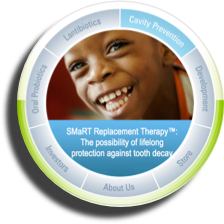The Dramatization:
At first it was small. The outbreak began in Florida’s Tampa Bay Area as local hospitals noticed an influx of patients with complaints of turquoise discolorations of their lips and aversion to simple carbohydrates. Once case histories were correlated it was noticed that all those who were affected had either recently received an inoculation of a mutant version of Streptococcus mutans at their dentist’s office or had been in close contact with someone who had.
Initially the culprit was thought to be excessive consumption of blue raspberry slushies, but by the time the CDC discovered that  an organism was responsible for these symptoms and that it was bacterial in origin and highly contagious the disease had spread far beyond Florida and had affected millions throughout the US and abroad.
an organism was responsible for these symptoms and that it was bacterial in origin and highly contagious the disease had spread far beyond Florida and had affected millions throughout the US and abroad.
There have been no reports of mortality, save the demise of the soft drink and candy industries. Sugar consumption has plummeted as more of the population becomes infected by this new strain of bacteria which was originally created to cure the problem of dental decay. Because persons who are affected display a noticeable change in their appearance, blue lips have become a strong signal of exclusion due to the fear surrounding this epidemic. However, as more evidence points to the positive outcomes of having been infected, the “blue look” is currently trendy in the larger cities. Blue-lipped patrons that had been banned from public venues such as restaurants and arena events are slowly trickling in, thanks to the assurances from the World Health Organization that this current situation has actually caused more good than harm. The long-term effects will be felt by dentists, who, in the next 30 years, will see an attrition of their necessity as caries becomes extinct, and possibly within the cosmetics industry with a shift in lip color preferences.
The Reality
Um, Yay? It’s been like, since the early 70’s that everyone’s been asking for a caries vaccine. And wouldn’t you know it? A company in the United States is already so ON this. Oragenics first initiated their first Phase 1 Clinical trials in 2005 but were halted by the FDA because of the fear of something happening like the above scenario. Think I’m kidding? Okay, maybe I was being sensational. But there can be genuine risks when you fiddle with a few genes, and the FDA seemed to be mainly concerned with the lack of a plan to eradicate attenuated strains in the test subjects’ children. AHHHHH!
It starts to get interesting when you look at the solution that Oragenics came up with to begin their second Phase 1 testing announced last week: The trial subjects will be inoculated with a strain of S. mutans that cannot survive without the amino acid D-alanine, which is not found in a normal human diet. This means that the subjects will have to feed their germs daily with a mouthwash to keep them from dying.
 Are you excited yet? Well, you’d better hold those horses back for a while. A long while. It’s going to take a bunch of time and a lot more money to get this to the market.
Are you excited yet? Well, you’d better hold those horses back for a while. A long while. It’s going to take a bunch of time and a lot more money to get this to the market.
The inoculation is designed to be a painless 5-minute treatment with a cotton-tipped swab to deliver the suspension of Oragenics’ patented bacterial strain into a patient’s mouth during routine dental visits. But this one won’t die without feeding. It will live forever.
And what is it supposed to do once it goes viral? Err… bacterial? Oragenics calls this treatment SMaRT Replacement Therapy™ and it promises to:
• Offer lifelong protection against tooth decay caused by S. mutans
• Eliminate the creation of lactic acid by oral bacteria
• Dramatically reduce the ability of S. mutans to cause tooth decay
• Be genetically stable
• Grow at a rate similar to non-genetically-altered S. mutans
• Aggressively displace the native, decay-causing strains of S. mutans and preemptive colonization of its niche
• Not cause any acute or chronic adverse side effects
I think it’s a foregone conclusion that this sort of genetic manipulation is probably the only way we’ll and break caries’ hold on humanity and the loss of teeth caused by decay. We can’t just kill all the bugs in our gut – all the Jamie Lee Curtis Activia commercials have given us TMI about probiotics lately – so it makes sense that this same premise is true in our mouths.
And the raspberry slushie is still your best bet for getting blue lips. Sorry, Oragenics will probably not be helping you there.
![]()

